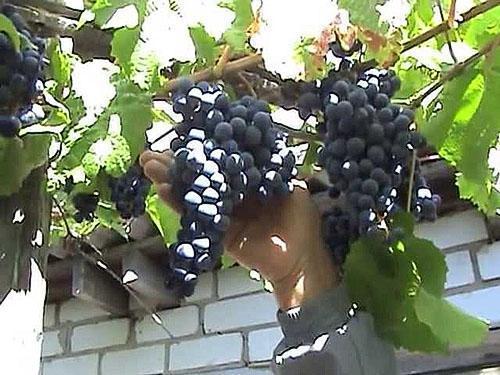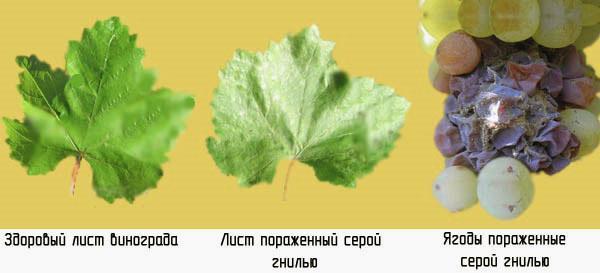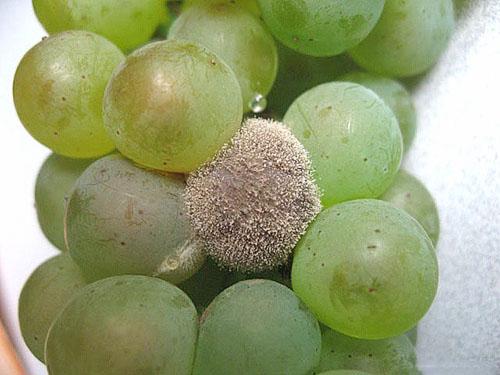Photo of grape diseases and the fight against them
 Often, growers of similar diseases caused by different fungi are called rot, without going into details. There is gray, white, black, sour, root rot.
Often, growers of similar diseases caused by different fungi are called rot, without going into details. There is gray, white, black, sour, root rot.
From various diseases of grapes, to combat them, the video (at the end of the article) shows treatment from a knapsack sprayer. The author processes several preparations with a tank mixture, which is cost-effective and saves labor. Several treatments are carried out during the season - depending on the weather, the state of the plantings, the presence of diseases or pests.
Gray rot on grapes

Gray rot on the leaves of grapes appears in the form of brown spots covered with a gray coating of conidiophores.
 In the heat, the affected part dies off. On the woody parts of the plant, the spots are white or light yellow, the berries turn brown. When the ridges of the bunches are damaged, they become greenish-brown, enlarge and decay. Leads to the fall of the bunches. On all spots, over time, a gray bloom is observed, dusting when touched: the fungus multiplies.
In the heat, the affected part dies off. On the woody parts of the plant, the spots are white or light yellow, the berries turn brown. When the ridges of the bunches are damaged, they become greenish-brown, enlarge and decay. Leads to the fall of the bunches. On all spots, over time, a gray bloom is observed, dusting when touched: the fungus multiplies.
Dangerous gray rot of grapes during the propagation of bushes, since Botrytis easily settles in places of grafting and does not allow callus to form.
The defeat of white varieties in hot dry season in the late stages of berry ripening can improve the sugar content and quality of the resulting wine. An additional harm on red varieties is the destruction of pigment by the fungus.
Gray rot on grapes, how to fight? You should know that copper-containing drugs are not effective enough. Drugs from the benzimidazole group (benomyl, cercobin, derozal) are good, but there are strains that are resistant to them. It will not be possible to destroy with one treatment. Treatment with 0.1% ronilan solution and 0.075% rovral helps. The first treatments are more advantageous to carry out with those anti-mildew preparations that simultaneously act on Botrytis. It is better to treat it with different preparations, this prevents the development of pest resistance and gives the best effect.
The folk method helps well - treatment with iodine solution. On a bucket - 30-50 drops, until a light yellow tint and a weak iodine smell appear. Treat once a decade or after rain.
Correct agrotechnology, prevention of thickening of the bush, timely implementation of green operations, proper feeding. In dry hot weather, the disease is always less.
White rot of grapes
 Called by the fungus Coniothyrium diplodiella Sacc. Plants are affected in hot weather, more often at the end of berry ripening. The berries turn brown, dry out, take on a boiled appearance, the color is purple, concentric. The leaves dry up, become dirty green, do not fall off. On the shoots, gray-white elongated spots, often ringing the shoots. Bumps of pycnidia are visible everywhere, at the end the color of the affected berries becomes off-white. Ripening pycnidia lift the skin of the berries, air penetrates between it and the pulp.The berries therefore appear white, the skin is easily removed - in a bag.
Called by the fungus Coniothyrium diplodiella Sacc. Plants are affected in hot weather, more often at the end of berry ripening. The berries turn brown, dry out, take on a boiled appearance, the color is purple, concentric. The leaves dry up, become dirty green, do not fall off. On the shoots, gray-white elongated spots, often ringing the shoots. Bumps of pycnidia are visible everywhere, at the end the color of the affected berries becomes off-white. Ripening pycnidia lift the skin of the berries, air penetrates between it and the pulp.The berries therefore appear white, the skin is easily removed - in a bag.
 Outbreaks of the disease are observed after hail, on burned berries, with thickened bushes. The need for processing separately from white rot is rare. Unless immediately after the hail, using copper-containing drugs or others.
Outbreaks of the disease are observed after hail, on burned berries, with thickened bushes. The need for processing separately from white rot is rare. Unless immediately after the hail, using copper-containing drugs or others.
Vineyard treatments against mildew or oidium also affect the causative agent of white rot of grapes.
Black rot of grapes, faded mouth

The causative agent Guignardia bidwellii requires moisture to infect plants for some time, otherwise the fungus will not invade the host cells. Landings near water bodies are more often affected, after mechanical damage, especially in the evening - dew loss at night contributes to infection.
 A brown spot appears on the berries with a white dot in the center. It grows, captures all the berries. Later, the fruits turn black and dry. In rainy weather, wet rot develops, in dry weather, the berries hang shriveled, mummified, dark purple or blue-black. For some time they keep on bunches, fall off in the fall. Serve, like dead leaves, a source of infection in the future.
A brown spot appears on the berries with a white dot in the center. It grows, captures all the berries. Later, the fruits turn black and dry. In rainy weather, wet rot develops, in dry weather, the berries hang shriveled, mummified, dark purple or blue-black. For some time they keep on bunches, fall off in the fall. Serve, like dead leaves, a source of infection in the future.
On the leaves, the disease manifests itself in the form of cream spots with a dark green border. The tissue inside the spots is dry and dead. On the shoots, spots in the form of black streaks. In the future, ulcers form, the bark cracks. It looks like a mildew, but it is impossible to confuse with the appearance of black pictids.
The trouble with this disease, like some others, is that the infection of the berry is invisible for a long time. And then the disease develops very quickly, and it is too late to cure ... Therefore, prevention is important, we start treatment before the signs of the disease appear.
It is important to prevent disease, remove leaves and fruits, shoots, grub up abandoned vineyards.
Root rot of grapes
 This is a group of diseases, grouped by external signs. The causative agents are mushrooms from different orders: imperfect, basidial, marsupials. This includes the defeat of psatirela, honeycomb, rosalinia.
This is a group of diseases, grouped by external signs. The causative agents are mushrooms from different orders: imperfect, basidial, marsupials. This includes the defeat of psatirela, honeycomb, rosalinia.
It is always easier to attack roots damaged by weather, mechanically, by pests - phylloxera, nematodes, ticks, etc. At first, fungi develop on dead roots, but gradually infect healthy ones.
The disease occurs on heavy, humus-rich, floating soils. On sandy loam soils poor in organic matter, the disease does not develop. At first, fungi develop as saprophytes on dead wood, then they move on to the developing roots of grapes and already behave like parasites.
Control measures
Chemical ones are ineffective, mainly reduced to preventing disease and removing affected bushes.
- Own-rooted European grapes should not be planted in heavy, poorly aerated soil or infested with fungi.
- Using mineral fertilizers instead of organic.
- Remove crop residues from the field.
- Uproot and remove dead or affected bushes.
- Adhere to proper farming practices. Loosen the soil on floating soils.
Sour rot of grapes
 The name is not associated with color (like many other rot), but with the smell: the affected berries have a vinegar smell. The smell arises from the vital activity of microorganisms that process the sugar of the berries into vinegar. Drosophila swarms nearby, small fruit flies, their larvae - tiny white worms - are inside the berries. Drosophila reproduce very quickly, which at one time made geneticists so happy. Alas, here they bring tangible harm, affecting grapes and causing the development of many diseases. It is easier for flies to penetrate damaged berries, on the other hand, they also carry yeast and fungi from berry to berry.
The name is not associated with color (like many other rot), but with the smell: the affected berries have a vinegar smell. The smell arises from the vital activity of microorganisms that process the sugar of the berries into vinegar. Drosophila swarms nearby, small fruit flies, their larvae - tiny white worms - are inside the berries. Drosophila reproduce very quickly, which at one time made geneticists so happy. Alas, here they bring tangible harm, affecting grapes and causing the development of many diseases. It is easier for flies to penetrate damaged berries, on the other hand, they also carry yeast and fungi from berry to berry.
 When the disease develops, we treat it with a mixture of fungicide and insecticide - from flies.If you are not sure that the preparations can be mixed (there are special tables, but they are not always at hand), then we prepare the solutions separately, drain them before use.
When the disease develops, we treat it with a mixture of fungicide and insecticide - from flies.If you are not sure that the preparations can be mixed (there are special tables, but they are not always at hand), then we prepare the solutions separately, drain them before use.